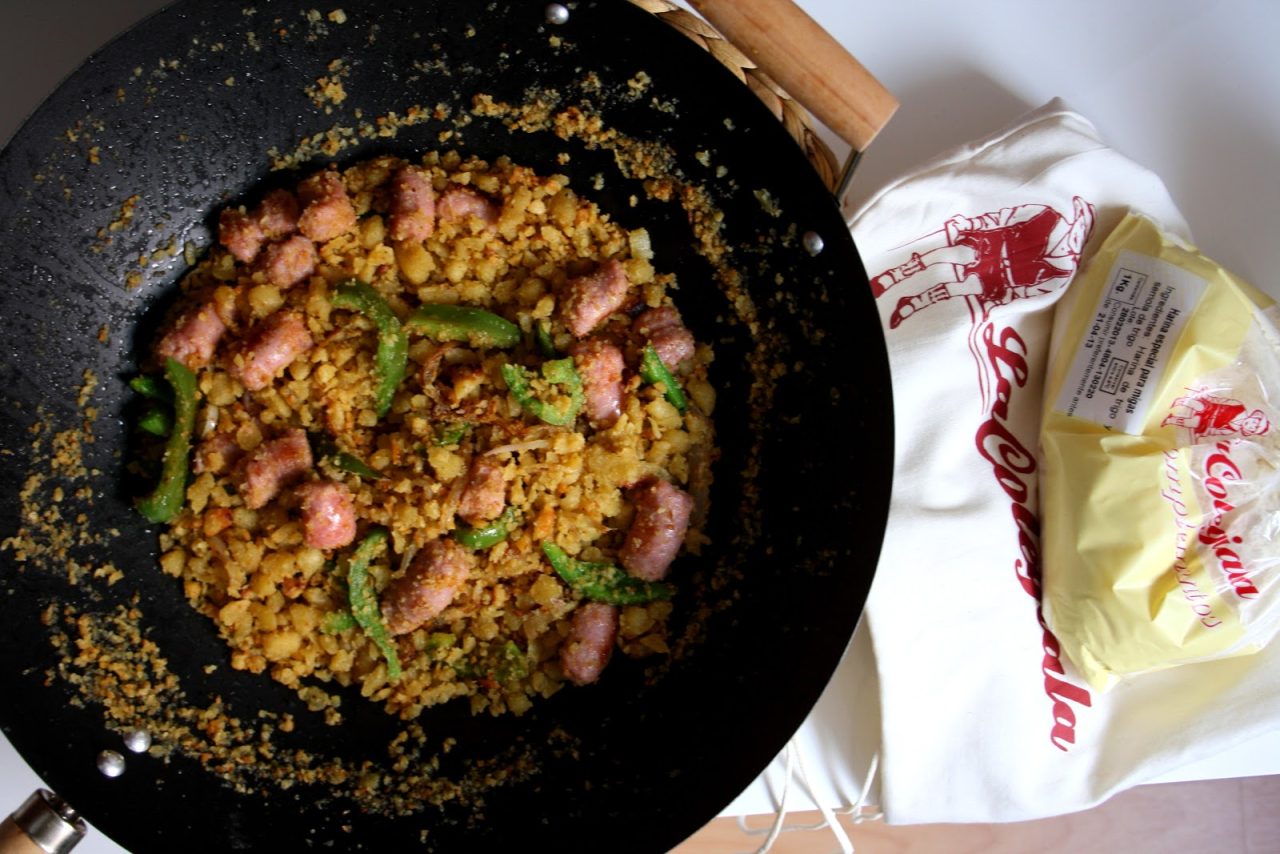Como hacer migas de harina murcianas
migas recipe
The Romans arrived in Hispania when the Celtiberian peoples were already eating fermented bread. Despite this, there is no record of the use of bread as an ingredient in the culinary preparations of the pre-Roman peoples. One of the first references to similar preparations whose ingredient is bread crumbs, or laminated bread, is found in the cuisine of the Roman Empire, in which slices of wet bread are prepared and sautéed with fat and various meat fragments; these may be the precursor preparations of randillas and torrijas. Puls and Roman legionary porridge may have been precursors, but although they are preparations with bread they are not reminiscent of migas in their final appearance.[10] The migas are made in a baking dish.
Crumbs are made in a frying pan or cauldron. It is preferable to use containers made of iron or steel materials, avoiding those made of clay or earth.[7] Containers in which the crumbs can be stirred continuously while a medium-high intensity heat source is applied are used. It is customary to mention that “a pan of crumbs” has been made. It is preferred to stir with wooden forks (ladle), before doing it with metal forks, allowing them to be stirred violently for several minutes.
The Romans arrived in Hispania when the Celtiberian peoples were already consuming fermented bread. Despite this, there is no record of the use of bread as an ingredient in the culinary preparations of the pre-Roman peoples. One of the first references to similar repairs whose ingredient is bread crumbs, or laminated bread, is found in the cuisine of the Roman Empire, in which slices of wet bread are prepared and sautéed with fat and various meat fragments; these may be the precursor preparations of randillas and torrijas. Puls and Roman legionary porridge may have been precursors, but although they are preparations with bread they are not reminiscent of migas in their final appearance.[10] The migas are made in a baking dish.
Crumbs are made in a frying pan or cauldron. It is preferable to use containers made of iron or steel materials, avoiding those made of clay or earth.[7] Containers in which the crumbs can be stirred continuously while a medium-high intensity heat source is applied are used. It is customary to mention that “a pan of crumbs” has been made. It is preferred to stir with wooden forks (ladle), before doing it with metal forks, allowing them to be stirred violently for several minutes.
crumbs spanish recipe
The proposal of resolution of the political groups supporting the imperialist policy of the EU constitutes a crude coercion for the citizens of the country to accept the constitutional changes dictated by imperialism and to comply with the suggestions prior to the elections
participating, as an indispensable condiment, in the preparation of most of its dishes: atascaburras, caldereta, moje de pimientos, pickled partridge, scrambled eggs, migas, gachas, etc. eur-lex.europa.eu
The fact that growing garlic was a popular activity is reflected in customs that have perdured, such as the garlic-stringing competitions; in folklore and in festivals, songs and stories, etc. eur-lex.europa.eu
Como hacer migas de harina murcianas online
I am going to highlight some Murcian recipes that I usually prepare at home and that I love, such as the traditional ensaladilla rusa (as my mother prepares it) and that is the one used for the classic marineras, those rosquilletas filled with ensaladilla rusa and an anchovy that are served in Murcia as a tapa. Another of my favorite recipes is the famous Caldero del Mar Menor, a mellow rice cooked with a broth that could not have more flavor, served with fish cooked in the same broth.
The migas are served freshly made and hot, that is how they are the most delicious, although it is also true that if you have leftovers you can keep them in the fridge in a closed container for 2-3 days without problems and even freeze them, they are not the same as freshly made but for a craving they are phenomenal.
There is the custom of mixing the flour, salt and water directly in the pan, emulating what shepherds used to do when they prepared them while they were shepherding. Fortunately in the kitchen we can have more than one container and it seems to me an excess of energy to control that the dough is homogeneous at the same time that the fire is on. Do not complicate unnecessarily, first mix the ingredients in a bowl comfortably and then pass it to the pan, your arm will thank you and your palate will not notice the difference, I even dare to say that this way there is more likely to come out better because the other way they tend to stick often and remain with lumps.
